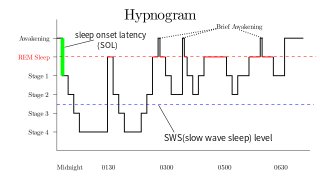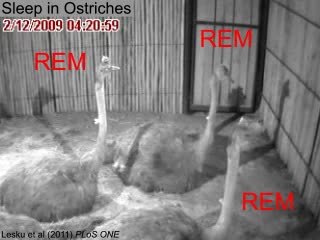Related Research Articles

Rapid eye movement sleep is a unique phase of sleep in humans, mammals and birds, characterized by random rapid movement of the eyes, accompanied by low muscle tone throughout the body, and the propensity of the sleeper to dream vividly.

Rapid eye movement sleep behavior disorder or REM behavior disorder (RBD) is a sleep disorder in which people act out their dreams. It involves abnormal behavior during the sleep phase with rapid eye movement (REM) sleep. The major feature of RBD is loss of muscle atonia during otherwise intact REM sleep. The loss of motor inhibition leads to sleep behaviors ranging from simple limb twitches to more complex integrated movements that can be violent or result in injury to either the individual or their bedmates.
William Charles Dement was an American sleep researcher and founder of the Sleep Research Center at Stanford University. He was a leading authority on sleep, sleep deprivation and the diagnosis and treatment of sleep disorders such as sleep apnea and narcolepsy. For this pioneering work in a previously uncharted field in the United States, he is sometimes referred to as the American father of sleep medicine.

The sleep cycle is an oscillation between the slow-wave and REM (paradoxical) phases of sleep. It is sometimes called the ultradian sleep cycle, sleep–dream cycle, or REM-NREM cycle, to distinguish it from the circadian alternation between sleep and wakefulness. In humans, this cycle takes 70 to 110 minutes.
Non-rapid eye movement sleep (NREM), also known as quiescent sleep, is, collectively, sleep stages 1–3, previously known as stages 1–4. Rapid eye movement sleep (REM) is not included. There are distinct electroencephalographic and other characteristics seen in each stage. Unlike REM sleep, there is usually little or no eye movement during these stages. Dreaming occurs during both sleep states, and muscles are not paralyzed as in REM sleep. People who do not go through the sleeping stages properly get stuck in NREM sleep, and because muscles are not paralyzed a person may be able to sleepwalk. According to studies, the mental activity that takes place during NREM sleep is believed to be thought-like, whereas REM sleep includes hallucinatory and bizarre content. NREM sleep is characteristic of dreamer-initiated friendliness, compared to REM sleep where it's more aggressive, implying that NREM is in charge of simulating friendly interactions. The mental activity that occurs in NREM and REM sleep is a result of two different mind generators, which also explains the difference in mental activity. In addition, there is a parasympathetic dominance during NREM. The reported differences between the REM and NREM activity are believed to arise from differences in the memory stages that occur during the two types of sleep.

Oneirology is the scientific study of dreams. Current research seeks correlations between dreaming and current knowledge about the functions of the brain, as well as understanding of how the brain works during dreaming as pertains to memory formation and mental disorders. The study of oneirology can be distinguished from dream interpretation in that the aim is to quantitatively study the process of dreams instead of analyzing the meaning behind them.
An oneirogen, from the Greek ὄνειρος óneiros meaning "dream" and gen "to create", is a substance or other stimulus which produces or enhances dreamlike states of consciousness. This is characterized by an immersive dream state similar to REM sleep, which can range from realistic to alien or abstract.
Wake therapy is a specific application of intentional sleep deprivation. It encompasses many sleep-restricting paradigms that aim to address mood disorders with a form of non-pharmacological therapy.

Slow-wave sleep (SWS), often referred to as deep sleep, consists of stage three of non-rapid eye movement sleep. It usually lasts between 70 and 90 minutes and takes place during the first hours of the night. Initially, SWS consisted of both Stage 3, which has 20–50 percent delta wave activity, and Stage 4, which has more than 50 percent delta wave activity.
Parasomnias are a category of sleep disorders that involve abnormal movements, behaviors, emotions, perceptions, and dreams that occur while falling asleep, sleeping, between sleep stages, or during arousal from sleep. Parasomnias are dissociated sleep states which are partial arousals during the transitions between wakefulness, NREM sleep, and REM sleep, and their combinations.
Thought suppression is a psychological defence mechanism. It is a type of motivated forgetting in which an individual consciously attempts to stop thinking about a particular thought. It is often associated with obsessive–compulsive disorder (OCD). OCD is when a person will repeatedly attempt to prevent or "neutralize" intrusive distressing thoughts centered on one or more obsessions. It is also thought to be a cause of memory inhibition, as shown by research using the think/no think paradigm. Thought suppression is relevant to both mental and behavioral levels, possibly leading to ironic effects that are contrary to intention. Ironic process theory is one cognitive model that can explain the paradoxical effect.

Sleep in animals refers to a behavioral and physiological state characterized by altered consciousness, reduced responsiveness to external stimuli, and homeostatic regulation observed in various animals. Sleep has been observed in mammals, birds, reptiles, amphibians, and some fish, and, in some form, in insects and even in simpler animals such as nematodes. The internal circadian clock promotes sleep at night for diurnal organisms and in the day for nocturnal organisms. Sleep patterns vary widely among species. It appears to be a requirement for all mammals and most other animals.
Alcohol, found in alcoholic beverages, can exacerbate sleep disturbances. During abstinence, sleep disruption is one of the greatest predictors of relapse.
Sleep deprivation, also known as sleep insufficiency or sleeplessness, is the condition of not having adequate duration and/or quality of sleep to support decent alertness, performance, and health. It can be either chronic or acute and may vary widely in severity.

Narcolepsy is a chronic neurological disorder that involves a decreased ability to regulate sleep–wake cycles. Symptoms often include periods of excessive daytime sleepiness and brief involuntary sleep episodes. About 70% of those affected also experience episodes of sudden loss of muscle strength, known as cataplexy. Narcolepsy paired with cataplexy is evidenced to be an autoimmune disorder. These experiences of cataplexy can be brought on by strong emotions. Less commonly, there may be vivid hallucinations or an inability to move while falling asleep or waking up. People with narcolepsy tend to sleep about the same number of hours per day as people without, but the quality of sleep tends to be lessened.
It has been estimated that over 20% of adults suffer from some form of sleep deprivation. Insomnia and sleep deprivation are common symptoms of depression, and can be an indication of other mental disorders. The consequences of not getting enough sleep could have dire results; not only to the health, cognition, energy level and the mood of the individual, but also to those around them as sleep deprivation increases the risk of human-error related accidents, especially with vigilance-based tasks involving technology.

The relationship between sleep and memory has been studied since at least the early 19th century. Memory, the cognitive process of storing and retrieving past experiences, learning and recognition, is a product of brain plasticity, the structural changes within synapses that create associations between stimuli. Stimuli are encoded within milliseconds; however, the long-term maintenance of memories can take additional minutes, days, or even years to fully consolidate and become a stable memory that is accessible. Therefore, the formation of a specific memory occurs rapidly, but the evolution of a memory is often an ongoing process.
Sleep is important in regulating metabolism. Mammalian sleep can be sub-divided into two distinct phases - REM and non-REM (NREM) sleep. In humans and cats, NREM sleep has four stages, where the third and fourth stages are considered slow-wave sleep (SWS). SWS is considered deep sleep, when metabolism is least active.

Sleep deprivation - the condition of not having enough sleep - is a common health issue for students in higher education. This issue has several underlying and negative consequences, but there are a few helpful improvements that students can make to reduce its frequency and severity.
Wake therapy is a specific application of intentional sleep deprivation, that encompasses many sleep-restricting paradigms that aim to address mood disorders with a form of non-pharmacological therapy.
References
- ↑ Myers, David (2004). Psychology (7th ed.). New York: Worth Publishers. p. 276. ISBN 0-7167-8595-1 . Retrieved 2010-01-09.
- 1 2 Carlson, Neil R. (2013). Physiology of behavior (11th ed.). Boston: Pearson. ISBN 9780205239399.
- ↑ Dement, William (10 June 1960). "The Effect of Dream Deprivation: The need for a certain amount of dreaming each night is suggested by recent experiments". Science. 131 (3415): 1705–1707. doi:10.1126/science.131.3415.1705. PMID 13815805.
- ↑ Timothy Roehrs & Thomas Roth (Feb 25, 2011). "Sleep, Sleepiness, and Alcohol Use". National Institute on Alcohol Abuse and Alcoholism of the National Institutes of Health. Retrieved 3 Nov 2011.
- ↑ "Does Drinking Alcohol Affect Sleep?". Alcohol & Drug Counseling, Assessment, & Prevention Services, WSU. Washington State University. Retrieved 7 May 2014.
- ↑ McCarthy, Andrew; Wafford, Keith; Shanks, Elaine; Ligocki, Marcin; Edgar, Dale M.; Dijk, Derk-Jan (2016-09-01). "REM sleep homeostasis in the absence of REM sleep: Effects of antidepressants". Neuropharmacology. 108: 415–425. doi: 10.1016/j.neuropharm.2016.04.047 . PMID 27150557.
- ↑ Pace-Schott, E. F.; Gersh, T.; Silvestri, R.; Stickgold, R.; Salzman, C.; Hobson, J. A. (June 2001). "SSRI treatment suppresses dream recall frequency but increases subjective dream intensity in normal subjects". Journal of Sleep Research. 10 (2): 129–142. doi: 10.1046/j.1365-2869.2001.00249.x . ISSN 0962-1105. PMID 11422727. S2CID 1612343.